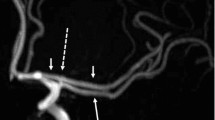Abstract
Bow hunter’s stroke (BHS) is a rare cause of vertebrobasilar insufficiency due to rotational vertebral artery (VA) occlusion associated with head turning. We report a juvenile patient presenting with recurrent ischemic stroke caused by BHS, which was revealed by carotid duplex ultrasonography. Carotid duplex ultrasonography performed in the neutral position showed normal findings. However, disappearance of end-diastolic blood flow of contralateral VAs was observed with head rotation. Digital subtraction angiography confirmed occlusion at C1/2 levels in the VA contralateral to the head rotation, bilaterally. Importantly, our patient did not recognize the association of head rotation and previous episodes of stroke. We suggest that BHS should be considered in patients with cryptogenic stroke occurring in the vertebrobasilar artery territory.


Similar content being viewed by others
References
Iguchi Y, Kimura K, Shibazaki K, et al. Transcranial doppler and carotid duplex ultrasonography findings in Bow hunter’s syndrome. J Neuroimaging. 2006;16:278–80.
Nakamura K, Saku Y, Torigoe R, et al. Sonographic detection of haemodynamic changes in a case of vertebrobasilar insufficiency. Neuroradiology. 1998;40:164–6.
Tanaka S, Inatomi Y, Yonehara T, et al. [Bow hunter’s syndrome with spontaneous improvement]. Rinsho Shinkeigaku. 2012;52:34–7.
Ikeda DS, Villelli N, Shaw A, et al. Bow hunter’s syndrome unmasked after contralateral vertebral artery sacrifice for aneurysmal subarachnoid hemorrhage. J Clin Neurosci. 2014;21:1044–6.
Cornelius JF, George B, N’Dri Oka D, et al. Bow-hunter’s syndrome caused by dynamic vertebral artery stenosis at the cranio-cervical junction—a management algorithm based on a systematic review and a clinical series. Neurosurg Rev. 2012;35:127–35 (Discussion 35).
Greiner HM, Abruzzo TA, Kabbouche M, et al. Rotational vertebral artery occlusion in a child with multiple strokes: a case-based update. Childs Nerv Syst. 2010;26:1669–74.
Hayashi K, Matsuo T, Kurihara M, et al. [A case of juvenile bow hunter’s stroke]. No To Shinkei. 2000;52:431–4.
Hope EE, Bodensteiner JB, Barnes P. Cerebral infarction related to neck position in an adolescent. Pediatrics. 1983;72:335–7.
Kuether TA, Nesbit GM, Clark WM, et al. Rotational vertebral artery occlusion: a mechanism of vertebrobasilar insufficiency. Neurosurgery. 1997;41:427–32 (Discussion 32–33).
Sakai K, Tsutsui T. Bow hunter’s stroke associated with atlantooccipital assimilation–-case report. Neurol Med Chir (Tokyo). 1999;39:696–700.
Sakamoto Y, Kimura K, Iguchi Y, et al. An embolic bow hunter’s stroke associated with anomaly of cervical spine. Neurology. 2011;77:1403–4.
Zaidi HA, Albuquerque FC, Chowdhry SA, et al. Diagnosis and management of bow hunter’s syndrome: 15-year experience at Barrow Neurological Institute. World Neurosurg. 2014;82:733–8.
Acknowledgments
The authors thank Dr. Hideaki Kanaya, Prof. Shunsuke Kawamoto, and Prof. Phyo Kim, Department of Neurosurgery, Dokkyo Medical University, for performing cerebral angiography and providing assistance on the patient’s diagnosis.
Conflict of interest
The authors declare that there is no conflict of interest.
Ethical standard
All procedures followed were in accordance with the ethical standards of the responsible committee on human experimentation (institutional and national) and with the Helsinki Declaration of 1975, as revised in 2008 (5). Informed consent was obtained from the patient for being included in the study.
Author information
Authors and Affiliations
Corresponding author
About this article
Cite this article
Takekawa, H., Suzuki, K., Nishihira, T. et al. Recurrent juvenile ischemic stroke caused by bow hunter’s stroke revealed by carotid duplex ultrasonography. J Med Ultrasonics 42, 437–440 (2015). https://doi.org/10.1007/s10396-015-0611-y
Received:
Accepted:
Published:
Issue Date:
DOI: https://doi.org/10.1007/s10396-015-0611-y




